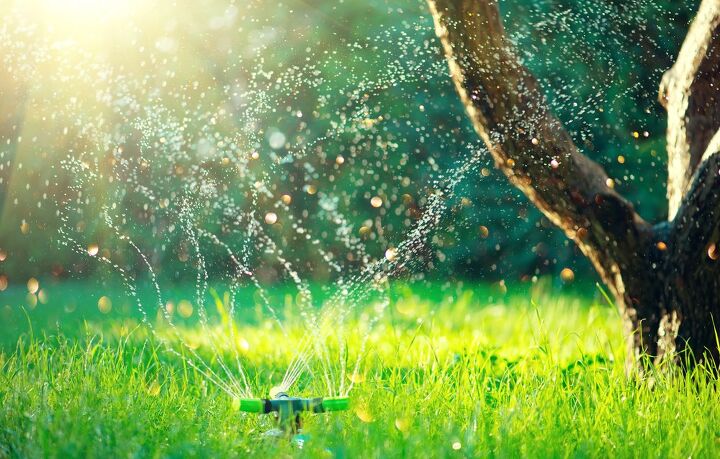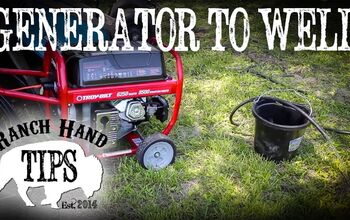When To Stop Watering Grass? (A State-By-State Guide)

There’s nothing like a healthy, green lawn, and I always want it to look that way. But, I never knew what time was right to stop watering it.
During the summer, a healthy lawn requires 1 ½ inches of water every week but watering dormant grass more than ½ inch can not only waste water, but prevent your grass from coming back healthy next spring. So when should you stop watering your lawn?
The key to knowing when to stop watering your lawn is to wait until the ground freezes. Until then, watering is just as important as the rest of the year. In colder parts of the country, this will happen part way through fall. In warmer climates, this will happen in the winter. Watering your lawn regularly is crucial for healthy grass in the summer, but watering your lawn in the winter months like January and December is unnecessary.
Do You Need Lawn and Tree Maintenace Pros?
Get free, zero-commitment quotes from pro contractors near you.

When Should I Stop Watering the Lawn?
One of the biggest mistakes homeowners make is abruptly cutting off the grass watering routine the moment the weather changes and the leaves start dropping. The fact is watering your lawn in the fall is just as important as the rest of the year. A sudden drop in moisture can shock your grass and cause it to dehydrate.
Your grass needs water whenever it can absorb it, and this means your lawn needs at least some water until the ground is frozen. Once the ground freezes, water is incapable of penetrating the surface and being absorbed by the plant’s roots.
This is why cold northern winters are said to create desert conditions. Even though when they hear the term “desert,” most people think of hot sands and cacti, it also describes cold climates where water is trapped in a frozen state.
Your grass survives this cold and dry state by entering a state of dormancy where they do not need water until the ground unfreezes and the temperature becomes warmer for a period of time.
Why Is It Important to Water In the Fall?
Depending on what type of grass you have, the point at which your grass’s blades stop growing will change. For some species, the fall is still an important growing season, even for the surface. However, the roots are another matter.
Even during the fall, grassroots will keep growing; in fact, the fall is an extremely important time of growth for grassroots. During this time, as the temperatures drop, the roots will grow, continuing to seek moisture.
This growth is critical to your grass’s ability to collect and build nutrients, and both survive the harsh winter and regrow in the spring and summer. Without this period of growth, there is a considerable risk your plants will enter winter with insufficient nutrients and will be incapable of making it to the spring.
The point in the year the ground typically becomes frozen, and you can stop watering is heavily dependent on the region, so let’s take a look at a few states to help you figure out when you can stop watering your grass.
How to Water Grass During the Fall?
It’s important to water your lawn in the fall until your ground freezes. However, it is also important not to overwater. Overwatering your lawn can lead to fungal diseases and harm your root system.
This means if you live in a region that receives suitable rainfall during the fall (generally approximately 1 inch), you will only have to water areas such as overseeded or new lawns. However, you will still need to be prepared to water during dry spells, just like in the summertime.
It is also best to remember to water the grass during the early morning to give it the whole day to dry out before the night. This also means that the evening is a poor time to water the lawn. An automatic sprinkler system can make this part easy. By simply setting a timer, you can get your grass watered at the best time and sleep in too.
When to Stop Watering Grass in Texas?
Texas has a harsh climate, and many homeowners are left wondering if they should keep watering even through the winter. So, let’s take a close look at when you should stop watering grass in Texas.
Most Texas homeowners are aware they need to water through the hot summer, and often they will even plant their grass to thrive in the extreme heat. But, when the fall hits, it isn’t time to cut watering yet if you hope for it to come back in the spring.
You do not need to keep watering throughout the winter as it will generally freeze by then and be rendered unnecessary. However, it remains warm through September and October, so well into fall Texas’ ground temperatures are high enough to call for watering.
Throughout October, watering should remain completely regular, and past this, a slightly more irregular schedule, perhaps once per week, may be suitable. This watering will also help to prevent winter mites when the time comes.
The reduced intensity of the sun does mean you can cut back on the quantity of water, but remember growth is still happening even if you can’t see it above the ground, so watering and fertilizer (slow release is a great idea) is still a must.
Watering will still be necessary into winter, demanding attention for when the temperature really begins to drop. When you’re cracking out the winter boots and jackets, it is time to stop watering your lawn
When to Stop Watering Grass in California?
In California, the ground does not freeze during the winter, and this begs the question, should you continue watering the grass through the winter. But generally, it does get wetter.
In the Los Angeles region, most warm-season grasses require one-third of an inch of rainfall every week during the winter. If the rainfall does not meet this amount, then you will need to make up for this amount with either manual hosing or preferably sprinklers. Cool-season grasses in the Los Angeles region will require about a half of an inch instead.
This means in many cases, you can stop watering your lawn during the winter, but only as long as you are receiving at least one and a half inches of rain during every winter month. So, start judging how much rain you are receiving starting in either October or November. If it is enough, you can stop watering unless there appears to be a dry winter.
If there does not appear to be a suitable amount of rain, try cutting back to approximately one thorough watering every week. Remember, it is okay if the grass becomes yellow in the winter, but it should never become completely brown.
When to Stop Watering Grass in Michigan?
In Michigan, your lawn will require light watering into early fall; however, always remember to try and water your grass from early morning to early afternoon. This will avoid potential fungal growth from having wet grass after nightfall.
Fortunately for your water bill, your lawn will only require about ½ inch of rainfall each week for you to have to do any watering. However, this does mean you will have to keep an eye on the rainfall.
When to Stop Watering Grass in South Carolina?
In South Carolina, as the weather starts to get colder in late fall to early winter, you should only water your lawn if rainfall becomes absent. At this time, warm-season lawns will begin their dormancy, and watering will only become necessary in cases of extreme dehydration. If this is necessary, only water the sparser patches that need to build extra growth, not the whole lawn. If the soil is moist during this time, it never needs to be watered
When to Stop Watering Grass in Virginia?
In Virginia, fall is an incredibly important growing season for the primary fescue lawns. This is because, after the intense heat of summer, the fall is when your lawn can begin to repair from the stress the heat will have caused and begin to grow. This is essential to preparing your lawn for the winter to come and all parts of this process will require watering for your lawn’s fertility.
Throughout fall, watering depends partially on the state of your lawn. If it has been recently aerated and seeded, attempt light, frequent watering twice daily until light puddling forms. Repeating this until germination is critical; when seedlings have grown to at least 2 inches, cut back the watering to once per day.
On established lawns watering is only necessary 2-3 times weekly to a combined total of about 1.5 inches. The deeper, more infrequent watering allows the soil to dry between waterings which is key to encouraging deeper root growth as the plants seek moisture. This will help your lawn to survive the winter and grow fuller and healthier than ever when spring returns.
It is important to keep the regular watering up until at least Thanksgiving, longer if the weather still has remained warm.
When to Stop Watering Grass in Utah?
Watering grass in the fall is still necessary for Utah. However, an adjustment in routine is critical to maintaining a healthy and luscious lawn. To help your lawn stay healthy throughout the winter, the quantity of watering necessary is less than during the summer months
Starting in September or for those living outside the Wasatch front, perhaps in December depending on the weather, you should begin to cut back watering to approximately every six-day spread throughout the month.
Try to ensure the waterings are deep to attempt to encourage deeper root development. Beginning in either November or December, you can begin to taper off watering altogether.
When to Stop Watering Grass in Nebraska?
The fall months in Nebraska do not mean you can cut off your watering schedule. During this season, the grass will continue to grow. It is still important to maintain a consistent watering schedule until the temperature drops low enough that the ground begins to freeze.
When to Stop Watering Grass in New Mexico?
Regular watering should continue through fall up until the first freeze in approximately mid-October. At this point, grass will enter its dormant season until approximately mid-March. However, these dates are only an approximation, so keep an eye on the weather to decide on a more firm date.
Once the first frost has occurred, it is time to begin winter watering. This watering schedule is far lighter than during the spring or summer. However, it’s important to provide the soil with enough moisture to survive these months.
A good rule for this is to water for about five minutes every 1-2 weeks. If there appears to be sufficient moisture in some parts of your lawn, lessen the watering and do not water in frozen patches at all, such as areas that remain frozen due to shade.
When to Stop Watering Grass in Minnesota?
Continue regular watering the same as usual. However, stop watering as soon as the first frost sets in. Generally, this will happen in about late October, and the grass will remain dormant until roughly April.
When to Stop Watering Grass in Colorado?
The Autumn brings colder temperatures in contrast to the scorching hot Colorado summer, but regular watering is still necessary to help the turf recover from the summer heat and prevent the emergence of winter mites. A good rule for watering during this time of the year is one-half to three-quarter inches of water per week.
Once the first frost hits, it is time to stop your regular watering routine, but with the dry Colorado winters, some winter watering will normally still be necessary for extended periods between snowfall. This generally can be done 1-2 times per month.
Do You Need Lawn and Tree Maintenace Pros?
Get free, zero-commitment quotes from pro contractors near you.

Final Words
Regular watering is the key to a great lawn and knowing when to stop watering grass is crucial to your lawn’s health and your utility bill. So, remember when the temperatures start dropping to consider when your lawn is ready to go dormant, and save yourself time and money.

We are a team of passionate homeowners, home improvement pros, and DIY enthusiasts who enjoy sharing home improvement, housekeeping, decorating, and more with other homeowners! Whether you're looking for a step-by-step guide on fixing an appliance or the cost of installing a fence, we've here to help.
More by Upgraded Home Team











![Finishing Basement Without Permit [Is It Really Illegal?]](https://cdn-fastly.upgradedhome.com/media/2023/07/31/9070078/finishing-basement-without-permit-is-it-really-illegal.jpg?size=350x220)















